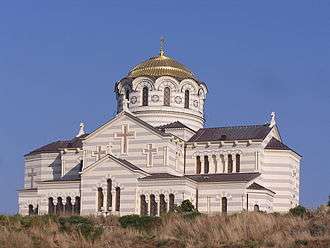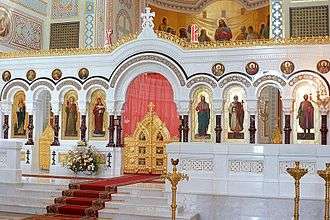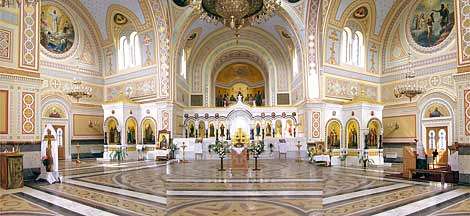Chersonesus Cathedral

The Saint Vladimir Cathedral is a Neo-Byzantine Russian Orthodox cathedral on the site of Chersonesos Taurica. It commemorates the presumed place of St. Vladimir's baptism.
History
According to legend and historic facts the baptism of Vladimir the Great took place in 988 in the Chersonese (or, as it was called by ancient Russian, Korsun), now - Chersonesos Taurica, a National Preserve near Sevastopol. In The Story of the Passing Years by the monk Nestor the city conciliar Church was mentioned: “in the middle of the city, where the inhabitants gather to trade”, which, as supposed, could be the probable place of the event crucial for the whole Rus.
The idea to immortalize the place of the Baptism of the Holy Prince Vladimir Equal-to-the-Apostles was first represented in 1825 by the Black Sea Fleet Chief vice-admiral Alexey Greig. On his initiative the excavations under the direction of K.Kruse were conducted in Chersonesos Taurica in 1827. As a result, the remains of the ancient Christian churches, including cruciform basilica were found out at the center of the market square.In 1830th the historians Frédéric Dubois de Montpéreux and N. Murzakevich made the conjecture that Vladimir the Great was baptized in this basilica. After that, all doubts about the place of the future Church dispelled. In 1850 by the petition of prelates of the church Innocent, archbishop of Chersonese and Tauric, St. Vladimir's Cloister was found. On August 23, 1850 grand laying of the foundation stone of the Church in honor of Saint Vladimir took place.
Building

The author of the project of St. Vladimir Cathedral in Chersonese was academician David Grimm. According to his plan, the Cathedral had to be built in Byzantine style. The construction took 15 years and was finished in 1874-1876, with the assistance of engineer M. Arnold. It was one of the biggest Cathedral of Russia (height – 36 m, total area – 1726 sq. m, dome diameter – 10,5 m) that could accommodate up to thousand church people.
The decoration of a Church began on the eve of 900th anniversary of the Baptism of Rus. It did not succeed to paint the Church for this significant date, that is why on June 13, 1888 to the Memorial Day of Grand Prince St. Vladimir only the Lower Church in honor of the Birth of Mary was consecrated. That year the iconostasis carved out of wood was placed at this Church and the interior work at Upper Church under the direction of architect Nikolay Chagin begun. The painting and icons for the central iconostasis of St. Vladimir Cathedral were made by academician Alexei Korzukhin. Furthermore, in the interior of the Cathedral it was also used works of the 1850th made by academician T. Neff, painter F. Riss, icons made by I.Maikov and E. Sorokin. Works out of marble, such as iconostasis of the Upper Church, mosaic floor of the Cathedral, marble balustrade along solea, were carried out by Italian masters J. Seppi and brothers Baskarini. Тhe consecration of the Cathedral took place on October 17, 1891, though the final decorative design was completed only in 1894.
As far back as 1859 the marble reliquary in form of Gospel with relics of Grand Prince St. Vladimir was passed from the Small Church of the Winter Palace in St. Petersburg to Chersonese. After the building of St. Vladimir Cathedral, his relics were was placed in the Lower Church near the ruins of the ancient basilica. At the Upper Church altar is situated the list from the miracle-working Korsun icon of the Mother of God, which, according to legend, was brought from Chersonese by Vladimir the Great. Altogether, the relics of 115 saints were passed to Cathedral.

Reconstruction

During World War II the cathedral was destroyed. The work on its restoration began in the late 1990s, even though it was made more active only in 2000. The project of the reconstruction was carried out by Kiev Institute “UkrProjectRestoration” under the direction of architect E. Osadchiy. From 2002 Vladimir Cathedral was painted by artists from St. Petersburg, Kiev and the Crimea, which recreated the lost painting of academician A. Korzuhin. On the walls of the Cathedral the contemporaries can see the following monumental compositions: “The Holy Spirit” (authors – L. Steblovska, E. Revenko) “The Baptism of Christ” (author – A. Dmitrenko), “The Transfiguration of Christ” (authors – L. Dmitrenko, N. Dmitrenko), “The Last Lord's Supper” (A. Pigarev, K.Popovskiy). The icons for marble iconostasis of the Upper Church were painted by young artists A. Dmitrenko and N. Dmitrenko.
The consecration of the high altar of Vladimir Cathedral in Chersonese took place on April 3, 2004, and in a week the Easter liturgy was officiated.
See also
| Wikimedia Commons has media related to St. Volodymyr's Cathedral, Chersones. |
External links
Coordinates: 44°36′44″N 33°29′36″E / 44.61222°N 33.49333°E
